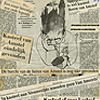De valkuilen van de historische sensatie Een pleidooi voor nuchter ‘getrennt marschieren’ inzake archeologisch-historische contradicties
DOI:
https://doi.org/10.18352/bmgn-lchr.10145Keywords:
History, archeology, Holy Roman Empire, tombAbstract
The Danger of Historical Sensation: A Plea for a Sober ‘getrennt marschieren’ regarding Archaeological-Historical Contradictions
Three issues will be discussed in this article – the castle of Amsterdam (1994-1995), the mikveh of Venlo and the King’s tomb of Middelburg – where initially a tangible archaeological find seems to support a spectacular historical theory. On closer inspection, the combination of archaeological and historical sources has not rendered conclusive interdisciplinary evidence, but only generated castles in the air, fairy tales or at least a version of the past that fails to do justice to both disciplines.
These issues are reason to highlight four methodological rules of thumb concerning historical-archaeological research. In order to prevent collective disillusionment, the most self-evident is to stay sober and down-to-earth and not to get stuck in a stage of enthusiastic intoxication or haze of ‘historical sensation’. Particularly in the case of fascinating historical-archaeological challenges this is a pitfall into which even very experienced researchers risk falling.
This article is part of the discussion forum 'At the Meeting Point of Historical Disciplines'.
In dit artikel worden drie kwesties besproken – het kasteel van Amsterdam (1994-1995), de mikwe van Venlo (2004-2014) en het koningsgraf van Willem II in Middelburg – waarbij een tastbare archeologische vondst aanvankelijk een sensationele historische theorie leek te ondersteunen. De combinatie van archeologische en historische bronnen bleek bij nader inzien geen sluitend interdisciplinair bewijs te leveren, maar slechts luchtkastelen, sprookjes of in elk geval een versie van het verleden die aan geen van beide disciplines recht deed.
Deze kwesties zijn aanleiding om vier methodische vuistregels inzake historischarcheologisch onderzoek voor het voetlicht te brengen. Het meest voor de hand liggend om een collectieve maatschappelijke kater te voorkomen is nuchter blijven en niet in de enthousiasmerende dronkenschap of roes van historische sensatie meegesleurd te worden. Juist bij fascinerende historisch-archeologische vraagstukken, is dat een valkuil waar ook zeer geoefende onderzoekers met open ogen in kunnen lopen.
Dit artikel maakt deel uit van het discussiedossier 'Op het raakvlak van historische disciplines'.
Downloads

Published
Issue
Section
License
Authors who publish with this journal agree to the following terms:
a) Authors retain copyright and grant the journal right of first publication with the work simultaneously licensed under a Creative Commons Attribution 4.0 International (CC BY 4.0) that allows others to share the work with an acknowledgement of the work's authorship and initial publication in this journal.
b) Authors are able to enter into separate, additional contractual arrangements for the non-exclusive distribution of the journal's published version of the work (e.g., post it to an institutional repository or publish it in a book), with an acknowledgement of its initial publication in this journal.
c) Authors are permitted to post their work online (e.g., in institutional repositories or on their website) prior to and during the submission process.
Authors are explicitly encouraged to deposit their published article in their institutional repository.







